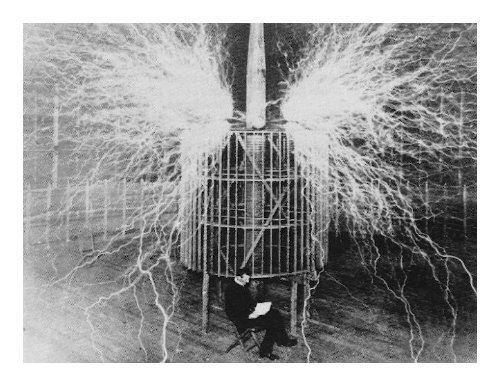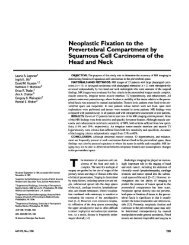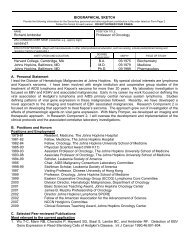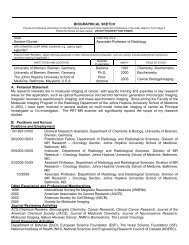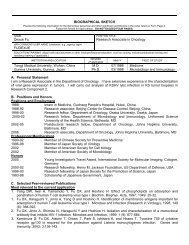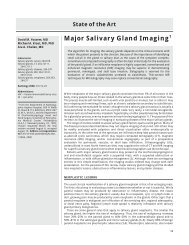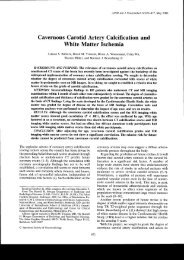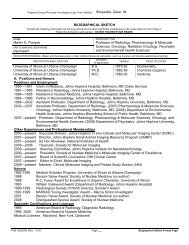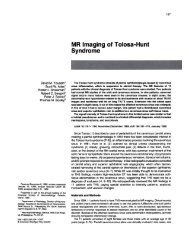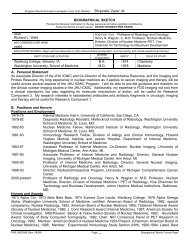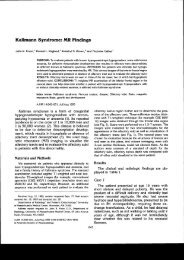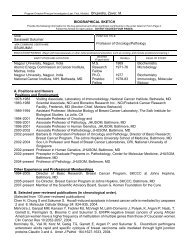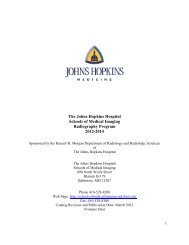MRI Update in Spinal Trauma and Spinal Cord Injury
MRI Update in Spinal Trauma and Spinal Cord Injury
MRI Update in Spinal Trauma and Spinal Cord Injury
You also want an ePaper? Increase the reach of your titles
YUMPU automatically turns print PDFs into web optimized ePapers that Google loves.
<strong>MRI</strong> <strong>Update</strong> <strong>in</strong><br />
Sp<strong>in</strong>al <strong>Trauma</strong> <strong>and</strong><br />
Sp<strong>in</strong>al <strong>Cord</strong> <strong>Injury</strong><br />
Adam Adam E. E. Fl<strong>and</strong>ers, M.D.<br />
M.D.<br />
Department of of Radiology<br />
Division of of Neuroradiology/ENT<br />
Regional Sp<strong>in</strong>al Sp<strong>in</strong>al <strong>Cord</strong> <strong>Cord</strong> <strong>Injury</strong> <strong>Injury</strong> Center<br />
Center<br />
of of the the Delaware Valley<br />
Valley<br />
Thomas Jefferson University Hospital<br />
Philadelphia, Pennsylvania
Web Syllabus<br />
There is an e-syllabus for this course.<br />
Appears on the web at the URL shown<br />
<strong>in</strong> the program.<br />
http://www.neuro.tju.edu/sp<strong>in</strong>e617<br />
http://www.neuro.tju.edu/rsnasp<strong>in</strong>e
Scope of the<br />
Problem<br />
SCI Etiology<br />
Violence<br />
MVA<br />
30%<br />
35%<br />
Injuries by Type<br />
Comp<br />
Inc Tetra<br />
Para<br />
28%<br />
30%<br />
Comp<br />
Inc Para<br />
Tetra<br />
23%<br />
19%<br />
Despite <strong>in</strong>creased public awareness<br />
<strong>and</strong> safety programs, SCI rema<strong>in</strong>s a<br />
significant problem.<br />
Incidence: 11,000 per year.<br />
Prevalence: 200,000 - 250,000.<br />
Mean age: 31.2 years.<br />
<br />
<br />
56% occur <strong>in</strong> 16 - 30 yr olds.<br />
Second peak <strong>in</strong> 60-70 range.<br />
82% males<br />
<br />
Others<br />
7%<br />
Sports<br />
8%<br />
whites > AA > hispanics<br />
Falls<br />
20%<br />
Peaks <strong>in</strong> Summer <strong>and</strong> Weekends
Imag<strong>in</strong>g Algorithm for Sp<strong>in</strong>e<br />
<strong>Trauma</strong><br />
Imag<strong>in</strong>g algorithms vary by <strong>in</strong>stitution<br />
<strong>and</strong> with<strong>in</strong> <strong>in</strong>stitutions depend<strong>in</strong>g upon:<br />
Cl<strong>in</strong>ical protocols & criteria are <strong>in</strong>stituted.<br />
How many different specialties “control”<br />
sp<strong>in</strong>al <strong>in</strong>jury.<br />
“Judgement” of <strong>in</strong>dividual physicians.<br />
Litigenous climate.
Imag<strong>in</strong>g Modalities<br />
Pla<strong>in</strong> Radiography (CR)<br />
Multiplanar Tomography<br />
Myelography<br />
Computed Tomography (CT)<br />
Magnetic Resonance Imag<strong>in</strong>g<br />
(<strong>MRI</strong>)
Imag<strong>in</strong>g Algorithm for Sp<strong>in</strong>e<br />
<strong>Trauma</strong><br />
Radiographs or Send Home<br />
CT<br />
Significant <strong>Trauma</strong><br />
Impaired sensorium<br />
Equivocal or positive radiographs, normal<br />
radiographs with severe pa<strong>in</strong>.<br />
<strong>MRI</strong><br />
Neurologic deficit (myelopathy(<br />
is significant).<br />
Impaired sensorium, , difficult to elicit neurologic<br />
exam.
What Has Changed<br />
Proliferation of Multidetector CT scanners.<br />
Maturation of Magnetic Resonance Imag<strong>in</strong>g<br />
as a cl<strong>in</strong>ical tool.<br />
New <strong>MRI</strong> techniques which have yet to<br />
reach the cl<strong>in</strong>ical doma<strong>in</strong>.<br />
Increased dependency on imag<strong>in</strong>g for<br />
patient management <strong>and</strong> treatment.<br />
Development of powerful, <strong>in</strong>expensive post-<br />
process<strong>in</strong>g workstations.
Multi-Detector Computed<br />
Tomography
S<strong>in</strong>gle vs Multidetector CT<br />
Images courtesy of www.ctisus.org<br />
<br />
<br />
<br />
Multi-detector or multi-slice CT exp<strong>and</strong>s spiral CT technology by<br />
acquir<strong>in</strong>g image data from multiple slices/locations at once.<br />
Permits much greater coverage <strong>in</strong> shorter period of time.<br />
Analysis of datasets with new 3D workstations.
Multidetector CT<br />
S<strong>in</strong>gle detector CT tradeoff <strong>in</strong> slice resolution versus<br />
coverage.<br />
Multi-detector provides both high slice resolution <strong>and</strong><br />
coverage.<br />
Typical scan now conta<strong>in</strong>s hundreds of images.<br />
Analysis of datasets with new 3D workstations.<br />
Old Paradigm:<br />
Focus on axial dataset; MPR secondary.<br />
New Paradigm:<br />
Focus on MPR dataset; review source data secondarily.
Multidetector CT<br />
2D Sagittal<br />
Reformats from a<br />
S<strong>in</strong>gle Detector CT<br />
2D Multiplanar reformatted images from a 16 detector CT<br />
axial dataset
Multidetector CT<br />
New paradigm for “tomographic” analysis
T5 Burst Fracture
2D Multiplanar/Curved Reformation
3D Surface Render<strong>in</strong>g
L3 Burst Fracture
2D Multiplanar Reformation
3D Surface Render<strong>in</strong>g
Cranial-Cervical Cervical Dislocation
BID
BID Surface Render<strong>in</strong>g
Replace Radiography with MDCT<br />
Digital dataset of whole body
Radiology Informatics<br />
Expectation of <strong>in</strong>stantaneous delivery of images <strong>and</strong> results
Too Much Data to H<strong>and</strong>le<br />
Soft copy <strong>in</strong>terpretation essential!!<br />
TRIP tm = Transform<strong>in</strong>g the<br />
Radiology<br />
Interpretation<br />
Process<br />
Discovery of <strong>in</strong>novative solutions to<br />
the problem of <strong>in</strong>formation/image<br />
data overload.<br />
Use of decision support tools, CAD.<br />
Improved man-mach<strong>in</strong>e mach<strong>in</strong>e <strong>in</strong>terfaces.
Magnetic Resonance Imag<strong>in</strong>g
Why Use <strong>MRI</strong> <strong>in</strong> Sp<strong>in</strong>al <strong>Injury</strong><br />
Offers most comprehensive eval of sp<strong>in</strong>al<br />
<strong>in</strong>jury <strong>and</strong> SCI.<br />
Depicts soft-tissue tissue component of the <strong>in</strong>jury.<br />
At many centers, the cl<strong>in</strong>ical evaluation is not<br />
complete without a <strong>MRI</strong> study.<br />
<strong>MRI</strong> has changed the cl<strong>in</strong>ical focus from the<br />
sp<strong>in</strong>e to the sp<strong>in</strong>al cord.<br />
Not supplanted radiographs <strong>and</strong> CT.<br />
<strong>MRI</strong> has replaced myelo <strong>and</strong> CTM.<br />
<strong>MRI</strong> is warranted <strong>in</strong> the acute period for any<br />
patient with a persistent neurologic deficit after<br />
trauma.<br />
SCIWORA
<strong>MRI</strong> Challenges
<strong>MRI</strong> Challenges<br />
<strong>MRI</strong> Challenges
Imag<strong>in</strong>g Objectives<br />
Good sagittal imag<strong>in</strong>g with dedicated<br />
surface coils is m<strong>and</strong>atory.<br />
All studies:<br />
Sagittal T1<br />
Sagittal T2 + FS<br />
Axial T2<br />
Cervical:<br />
Sagittal GRE<br />
Sagittal PD<br />
Axial GRE<br />
Axial 2DTOF MRA<br />
No role for gadol<strong>in</strong>ium
How is <strong>MRI</strong> used as a cl<strong>in</strong>ical tool<br />
Open versus closed reduction of <strong>in</strong>jury.<br />
<strong>MRI</strong> prior to or after reduction<br />
Herniated disc or epidural clot compress<strong>in</strong>g cord.<br />
Tim<strong>in</strong>g of surgery (controversial!)<br />
Early versus late decompression <strong>and</strong> fusion.<br />
Incomplete/Complete motor <strong>in</strong>jury.<br />
Type of surgery<br />
Anterior <strong>and</strong>/or posterior fusion.<br />
Integrity of ligaments, discs, anterior, middle <strong>and</strong><br />
posterior columns<br />
<strong>MRI</strong> assessment plays significant role <strong>in</strong> determ<strong>in</strong><strong>in</strong>g<br />
or confirm<strong>in</strong>g the surgical formula.<br />
Prognosis
Characterization of Sp<strong>in</strong>al <strong>Injury</strong><br />
with <strong>MRI</strong><br />
Spectrum of <strong>in</strong>juries depicted with<br />
<strong>MRI</strong> subdivided <strong>in</strong>to:<br />
Fractures<br />
Disc <strong>Injury</strong> or Herniation<br />
Ligament Disruption, Stra<strong>in</strong><br />
Extradural Fluid (Hematoma)<br />
Vascular <strong>Injury</strong><br />
Sp<strong>in</strong>al <strong>Cord</strong> <strong>Injury</strong>
<strong>MRI</strong> & Vertebral Fractures<br />
L5 Axial Load<strong>in</strong>g <strong>Injury</strong><br />
PDW<br />
PDW
MR/CT Comparison of Vertebral<br />
Fractures<br />
3DFT GRE<br />
CT
Fracture Induced Marrow Changes<br />
L2<br />
L2
Large Cervical Disc Herniation<br />
Sag T1<br />
Sag PD<br />
Sag T2
Large Cervical Disc Herniation<br />
Axial GRE<br />
Axial GRE
Extension-Type <strong>Injury</strong><br />
T2W<br />
T2W
Fractures & Ligament <strong>Injury</strong><br />
Extension-<br />
Teardrop<br />
Fracture of C2<br />
T2W (2000/80/2 NEX)
Hyperflexion Type Injuries<br />
T2W<br />
T2W
Flexion-distraction Type <strong>Injury</strong><br />
15 y/o wrestler<br />
T1W<br />
T2W<br />
T2W
Ligament Disruption<br />
T12-L1 Fracture Dislocation<br />
(PDWI)
<strong>Injury</strong> to ALL <strong>and</strong> LF<br />
C7<br />
C7
3 Column Ligamentous Disruption<br />
T2W<br />
T2W
How Well Does MR Predict<br />
Ligamentous Damage<br />
Detection of PLC <strong>Injury</strong><br />
Sens % Spec % Pos PV % Neg PV % Accuracy %<br />
Palpation 52.0 66.7 92.9 14.3 53.6<br />
Radiograph 66.7 66.7 95.2 16.7 66.7<br />
<strong>MRI</strong> SSL 92.9 80.0 96.3 67.6 90.9<br />
<strong>MRI</strong> ISL 100 75.0 96.7 100 97.0<br />
<strong>MRI</strong> LF 85.7 88.5 66.7 95.8 87.9<br />
Lee HM etal. Sp<strong>in</strong>e 2000
Unilateral Facet Dislocation C4-5
Epidural Hematoma<br />
L2<br />
PDW<br />
T2W
<strong>Trauma</strong>tic Occlusion of the<br />
Vertebral Artery<br />
2DTOF MIP<br />
2DTOF MIP
<strong>Trauma</strong>tic Occlusion of RVA
<strong>MRI</strong> of Sp<strong>in</strong>al <strong>Cord</strong> <strong>Injury</strong>
<strong>MRI</strong> F<strong>in</strong>d<strong>in</strong>gs of SCI<br />
Features of SCI on <strong>MRI</strong> <strong>in</strong>clude:<br />
Sp<strong>in</strong>al <strong>Cord</strong> Swell<strong>in</strong>g<br />
Sp<strong>in</strong>al <strong>Cord</strong> Edema<br />
Sp<strong>in</strong>al <strong>Cord</strong> Hemorrhage<br />
Edema length prop to neurologic deficit<br />
<strong>and</strong> prognosis.<br />
Heme associated with most severe<br />
<strong>in</strong>juries <strong>and</strong> predicts poor neurologic<br />
recovery.<br />
Heme location correlates with NLI.
Sp<strong>in</strong>al <strong>Cord</strong> Edema<br />
C4<br />
T2W<br />
T2W
Acute Hemorrhagic SCI<br />
GRE<br />
T2W<br />
GRE
Hemorrhagic <strong>Cord</strong> <strong>Injury</strong><br />
T1W<br />
gross sections<br />
T2W<br />
H&E micrograph
Hemorrhagic SCI<br />
s/p C6-7 7 subluxation, ASIA B<br />
T2W<br />
T2W<br />
gross x-sectionsx<br />
gross
Brown-Sequard<br />
Syndrome<br />
s/p stab wound with screwdriver<br />
GRE<br />
gross x-sectionsx<br />
T1W<br />
GRE
Brown-Sequard<br />
Syndrome<br />
s/p stab wound<br />
T2W<br />
T2W
BID & <strong>Cord</strong> Transection
Correlat<strong>in</strong>g MR Parameters with<br />
Neurologic Deficit <strong>in</strong> SCI
Mean Edema Length (units) by ASIA<br />
Grade<br />
(ANOVA: A>B,C,D & B>D)
Correlation Between Edema Length <strong>and</strong> UE<br />
%RR.<br />
R 2 =.389
Effect of Sp<strong>in</strong>al <strong>Cord</strong> Heme on UE Motor<br />
Recovery at 12 mos.<br />
(t = 5.952, df =37, p < .0001)
Effect of Sp<strong>in</strong>al <strong>Cord</strong> Heme on LE Motor<br />
Recovery at 12 mos.<br />
(t = 5.952, df =37, p < .0001)
Relationship of Sp<strong>in</strong>al <strong>Cord</strong> Hemorrhage to<br />
Mean Admission FIM Subscales
Relationship of Sp<strong>in</strong>al <strong>Cord</strong> Hemorrhage<br />
to Mean Discharge FIM Subscales
Effects of Steroids on SCI
<strong>MRI</strong> Comparison<br />
FSE T2<br />
20M C5 ASIA A (-) MPS<br />
FSE T2<br />
29F C5 ASIA A (+) MPS
Results<br />
Presence of Hemorrhage<br />
Steroids<br />
(+) MPS<br />
(-)) MPS<br />
(+) Heme<br />
54%<br />
85%<br />
(-) Heme<br />
46%<br />
15%<br />
(p = 0.0007)
Results<br />
Mean Total Lesion Length*<br />
(-)) MPS<br />
(+) MPS<br />
p<br />
C4-6<br />
10.4<br />
><br />
8.6<br />
0.031<br />
C4<br />
10.2<br />
<<br />
11.1<br />
0.44<br />
C5<br />
11.2<br />
><br />
7.1<br />
0.007<br />
C6<br />
10.9<br />
><br />
7.0<br />
0.027<br />
(* Arbitrary units)
Results<br />
Mean Hemorrhage Length*<br />
(-)) MPS<br />
(+) MPS<br />
p<br />
C4-6<br />
2.7<br />
><br />
1.4<br />
0.076<br />
C4<br />
2.6<br />
><br />
2.0<br />
0.619<br />
C5<br />
2.8<br />
><br />
1.0<br />
0.149<br />
C6<br />
2.9<br />
><br />
1.0<br />
0.189<br />
(*Arbitrary units)
Evolution of Sp<strong>in</strong>al <strong>Cord</strong> <strong>Injury</strong><br />
18 y/o C5 ASIA A<br />
T1WI<br />
T2W<br />
T1WI<br />
T2W<br />
Initial<br />
2 months post <strong>in</strong>jury
Chronic Changes follow<strong>in</strong>g SCI<br />
Atrophy<br />
Atrophy & Myelomalacia<br />
Syr<strong>in</strong>x & Myelomalacia
Chronic Changes after SCI<br />
tether<strong>in</strong>g, adhesions & cyst
Atrophy & Myelomalacia<br />
10 mos. after crush <strong>in</strong>jury<br />
T1W<br />
T2W
Deterioration at 10 days<br />
C5 level ascend<strong>in</strong>g to C3<br />
C6<br />
C6<br />
C6
Future of <strong>MRI</strong> & SCI<br />
Future developments <strong>in</strong> imag<strong>in</strong>g of SCI<br />
parallel progress <strong>in</strong> functional imag<strong>in</strong>g.<br />
Diffusion, perfusion MRS <strong>and</strong> BOLD<br />
imag<strong>in</strong>g of sp<strong>in</strong>al cord will improve our<br />
precision <strong>in</strong> assess<strong>in</strong>g sp<strong>in</strong>al cord<br />
function.<br />
<strong>MRI</strong> will also prove <strong>in</strong>valuable <strong>in</strong><br />
evaluat<strong>in</strong>g viability of transplants.
f<strong>MRI</strong> Signal Generated by Biceps<br />
Contraction<br />
Exploits subtle changes <strong>in</strong><br />
blood O 2 levels detectable<br />
on <strong>MRI</strong>.<br />
Currently used to study<br />
bra<strong>in</strong> cortical activation.<br />
BOLD signal has been<br />
successfully elicited from<br />
human sp<strong>in</strong>al cords.<br />
Future application <strong>in</strong><br />
underst<strong>and</strong><strong>in</strong>g cord<br />
function & plasticity <strong>in</strong><br />
recovery.<br />
C5<br />
Madi et al. AJNR 2001
Activation & Deactivation Dur<strong>in</strong>g<br />
Isometric Contraction<br />
Isometric Contractions<br />
Madi etal AJNR 2001
Diffusion Characteristics of<br />
Normal Sp<strong>in</strong>al <strong>Cord</strong><br />
Rout<strong>in</strong>ely used to diagnose<br />
<strong>in</strong>farction <strong>and</strong> to map fiber<br />
tracts <strong>in</strong> bra<strong>in</strong>.<br />
Diffusion correlates with<br />
<strong>in</strong>tegrity of myel<strong>in</strong> sheath &<br />
neuronal function.<br />
SC consists of ordered<br />
bundles of myel<strong>in</strong>ated<br />
fibers.<br />
Free diffusion of water is<br />
“unrestricted” along axis of<br />
normal neurons.<br />
Rat: ex-vivo<br />
Courtesy of Eric D. Schwartz, MD, Hospital of the University of Pennsylvania
Transplant <strong>and</strong> Histology<br />
Rat: ex-vivo<br />
Rat: ex-vivo<br />
Courtesy of Eric D. Schwartz, MD, Hospital of the University of Pennsylvania
Diffusion Characteristics of Sp<strong>in</strong>al<br />
1 mm rostral to Fb-BDNF<br />
transplant<br />
<strong>Cord</strong> Transplants<br />
1 mm rostral to Fb-UM transplant<br />
Courtesy of Eric D. Schwartz, MD, Hospital of the University of Pennsylvania
DTI <strong>and</strong> Sp<strong>in</strong>al <strong>Cord</strong> Fiber Track<strong>in</strong>g <strong>in</strong> Normal<br />
Courtesy of Eric D. Schwartz, MD, Hospital of the University of Pennsylvania
DTI <strong>and</strong> Sp<strong>in</strong>al <strong>Cord</strong> Fiber Track<strong>in</strong>g at 9.4T<br />
Courtesy of Eric D. Schwartz, MD, Hospital of the University of Pennsylvania
Controversies!<br />
Too much data to h<strong>and</strong>le!!!<br />
Replac<strong>in</strong>g radiography with CT.<br />
When is CT or <strong>MRI</strong> appropriate<br />
Assess<strong>in</strong>g stability.<br />
C1-2 2 <strong>in</strong>stability (“crooked(<br />
dens”).<br />
r/o lig <strong>in</strong>jury w/o fracture.<br />
Use of <strong>MRI</strong> as alternative to<br />
flexion/extension.
Assess<strong>in</strong>g Instability<br />
Scenario: Cervical spra<strong>in</strong><br />
No fx, , no neurologic deficit<br />
residual pa<strong>in</strong>, motion limitation<br />
Rx Option #1<br />
Meds & home <strong>in</strong> soft collar.<br />
Follow-up<br />
outpt flex/ex views.<br />
Rx Option #2<br />
Get emergent <strong>MRI</strong> to assess<br />
<strong>in</strong>tegrity of ligaments.<br />
Has <strong>MRI</strong> been validated to<br />
determ<strong>in</strong>e mechanical<br />
stability<br />
Ext<br />
Flex
Tilted Dens Scenario
Tilted Dens Scenario<br />
* *<br />
*<br />
T2W<br />
T2W<br />
Are the ligaments truly <strong>in</strong>tact or is the <strong>MRI</strong> <strong>in</strong>sensitive
Question<br />
We rely on <strong>MRI</strong> to determ<strong>in</strong>e if it’s:<br />
Safe to discharge patients<br />
For obtunded or unreliable pt:<br />
Safe to allow a patient to move (stability).<br />
Safe to discharge pt.<br />
To confirm or refute neurologic exam<strong>in</strong>ation.<br />
We enjoy a false sense of comfort that <strong>MRI</strong><br />
shows all these essential features with a high<br />
degree of reliability, yet many aspects have not<br />
been validated.
Summary<br />
Radiography <strong>and</strong> CT are primary<br />
diagnostic modalities <strong>in</strong> <strong>in</strong>itial eval.<br />
of SCI.<br />
MDCT improves our accuracy to<br />
detect <strong>and</strong> characterize fractures.<br />
<strong>MRI</strong> is required <strong>in</strong> all sp<strong>in</strong>al <strong>in</strong>jured<br />
patients with a persistent<br />
neurologic deficit.
Summary<br />
<strong>MRI</strong> improves the prognostic<br />
capabilities of cl<strong>in</strong>ical exam<strong>in</strong>ation.<br />
<strong>MRI</strong> is study of choice for eval of<br />
chronic SCI.<br />
New <strong>MRI</strong> techniques may provide<br />
new parameters to assess<br />
restoration of function follow<strong>in</strong>g<br />
therapy.<br />
New workflow paradigms are<br />
needed to accommodate to data<br />
overload.
Thanks to the Regional Sp<strong>in</strong>al<br />
<strong>Cord</strong> <strong>Injury</strong> Center of the<br />
Delaware Valley.<br />
John F. Ditunno, MD<br />
Anthony S. Burns, MD<br />
Eric D. Schwartz, MD
Thank You!


